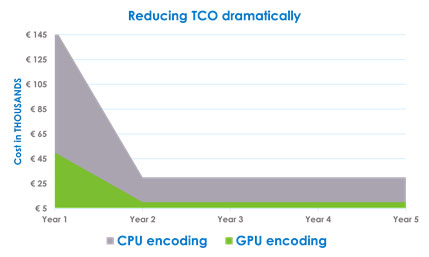The landscape of global video streaming solutions will never be the same again.
An innovative new line of GPU-acceleration encoding cards from MediaKind is set to achieve the holy trifecta of video creation: superior broadcast quality, significant cost reduction and highly improved ESG (environment-society-governance) scores. Tests have delivered up to 70% energy savings, compared to CPU-based encoding technology. Results comparing a 48-channel CPU-only deployment vs. a GPU-based server deployment reduces the total-cost-of-ownership (TCO) of up to $200k over 5 years. This also saves over 50 tonnes of CO2e – the equivalent of flying from Paris to New York 100 times.
The novel GPU-based solution is a triple win for businesses – providing significant relief to operating expenses, cutting energy consumption by a major chunk and reducing capital expenditure, all the while maintaining high standards in key criteria including rack density and picture quality. It makes a compelling business case for clients looking to achieve sustainability goals without surrendering an inch on the performance front.
GPU vs. CPU explained: Why a GPU is the better option
Generally, video encoding is an extremely power-hungry function, with as much as one-third of the computing capacity in the average datacenter being consumed during its processing. Balancing quality performance whilst keeping costs and carbon dioxide emissions in check has so far proved to be a major challenge for the industry.
MediaKind’s new proprietary technology is tackling this issue head-on: optimising energy usage and reducing emissions during the video streaming process, thereby enabling considerably ‘greener’ video creation.
To understand why MediaKind’s GPU video encoding technology is superior to CPU-based encoding, however, we need to first understand the primary differences between a CPU and a GPU.
A Central Processing Unit (CPU) is a generalist component handling all the main functions of a computer, while a Graphics Processing Unit (GPU) is a specialised component that excels at running multiple smaller tasks simultaneously. Given GPUs have many more cores than CPUs, they can handle many more concurrent mathematical and geographical calculations with greater efficiency. This means that GPUs are better suited for complex processing tasks such as video encoding, where many small tasks need to be completed in parallel.
GPU-accelerated computing, i.e. the employment of a GPU along with a CPU, facilitates a higher quality of video playback using accelerated effects and transitions in real-time without having to render them separately. The end-product is far superior than sole CPU-powered ones.
Greener Video Operations: Achieving climate goals while reducing costs
MediaKind’s GPU video encoding technology takes on this complex processing with utmost dexterity, freeing up the server’s main CPU(s) for more generic workloads and delivering up to 70% energy savings compared to CPU-based encoding.

Test results comparing a 48-channel CPU-only deployment vis-à-vis a GPU-based server deployment were found to reduce the total cost of ownership (TCO) metric by up to $200,000 over five years. Results also found the technology achieves reductions of about 65% for the encoding servers, making it ideal for businesses looking to optimise their data centre infrastructure. By using less power – the equivalent power per channel metric was as low as 13W for an IPTV HD channel (30FPS) and 78W for a UHD OTT profile (60FPS) – it reduces cooling requirements and associated costs as well.

MediaKind’s GPU-based solution fully supports the H.264 and HEVC codecs and does not require any complex implementation for customers to deploy it. Customers can also choose to bring their own servers, so there is no reliance on bespoke hardware. The solution can be deployed on their own servers and the channels can be managed from the same user-friendly MediaKind interface with the same licensing model.
By consuming considerably less power and providing consistently higher levels of output compared to its peers, MediaKind clearly sets itself apart as the most viable option in a highly competitive industry, and makes it a no-brainer for customers to invest in this technology.
Contact your MediaKind representative to understand how this technology can help your organisation save costs and meet its sustainability goals.
Read more about our G8 server with SG1 and other card options here: https://www.mediakind.com/wp-content/uploads/2020/10/G8-Datasheet.pdf and our Aquila Streaming and Broadcast solutions.



